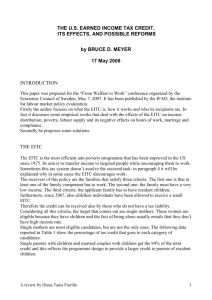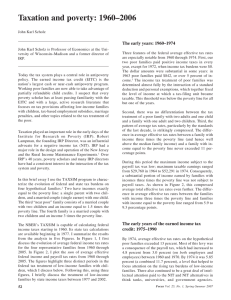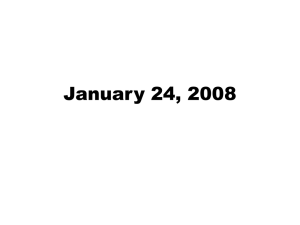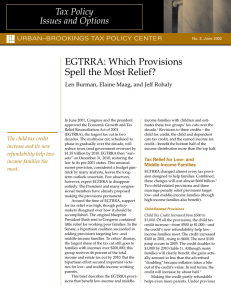Income Inequality: Theory
advertisement
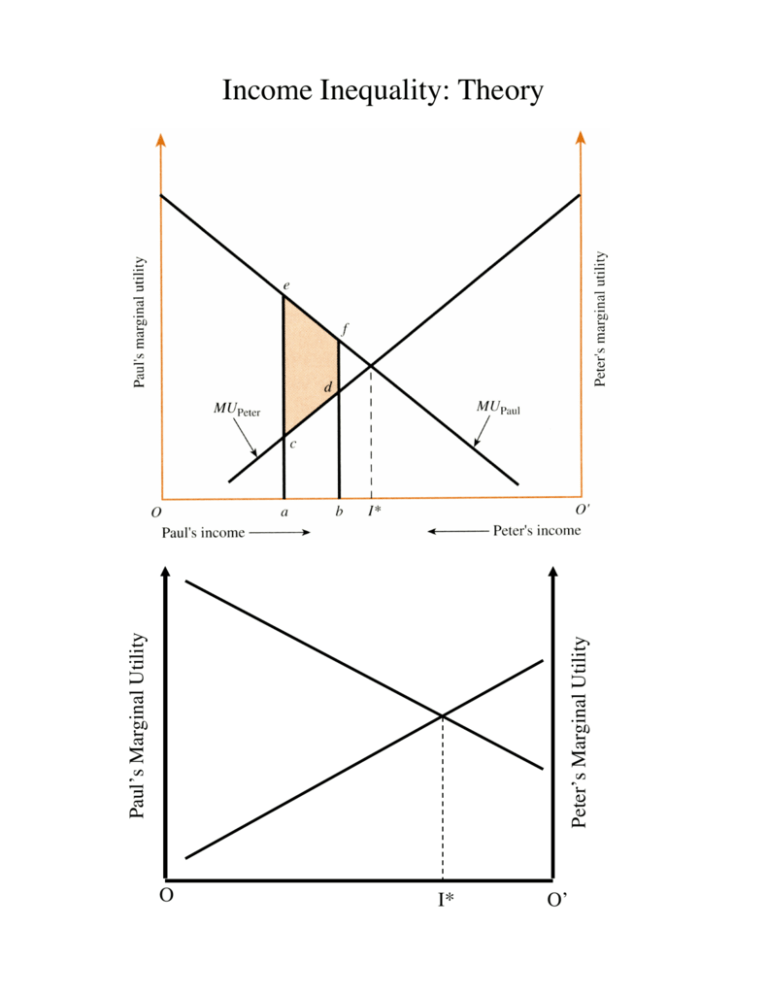
Peter’s Marginal Utility Paul’s Marginal Utility Income Inequality: Theory O I* O’ Income Inequality in the US Over Time Question: What fraction of all household income is received by the poorest fifth (quintile 1)? The second-poorest? etc. Q5/Q1 is the ratio of the income received by the richest fifth to income received by the poorest fifth. Year 1968 1975 1980 1985 1990 1993 1996 1999 Fraction of Pretax Income Received By Quintile 1 2 3 4 5 4.2 11.1 17.5 24.4 42.8 4.4 10.5 17.1 24.8 43.2 4.3 10.3 16.9 24.9 43.7 4.0 9.7 16.3 24.6 45.3 3.9 9.6 15.9 24.0 46.6 3.6 9.0 15.1 23.5 48.9 3.7 9.0 15.1 23.3 49.0 3.6 8.9 14.9 23.2 49.4 Q5/Q1 10.2 9.8 10.2 11.3 11.9 13.6 13.2 13.7 Source: US Census Bureau, Report P60-209, Table C. Facts: - “Hollowing” of distribution: income received by Q3 has substantially declined Income of Q1 declined 1968-1993, has stayed about the same since 1993 Income received by Q5 increased sharply 1968-1993, has stayed same since 93 Tax policy: - Roughly constant 1968-1980 - Sharp cuts at the top in 1980s - Substantial tax increases at the very top (top 1 percent) in the 1990s - Substantial tax cuts at the bottom (Earned Income Tax Credit) in 1990s New Racial Groups The estimates in this report are based on the Current Population Survey (CPS) 2001, 2002, and 2003 Annual Social and Economic Supplement (ASEC) and provide information for calendar years 2000, 2001, and 2002, respectively. For the first time in 2003, CPS respondents were asked to identify themselves in one or more racial groups;5 previously they had to choose one. This change complicates year-to-year comparisons. We do not know how people who reported more than one race in 2002 previously reported their race. Therefore, there is no single way to compare changes to poverty by race. 5 OMB establishes the official guidelines for the collection and classification of data for race (including the option for respondents to mark more than race) and Hispanic origin. Race and Hispanic origin are treated as separate and distinct concepts in accordance with OMB’s guidelines. For further information, see www.whitehouse.gov /omb/ombdir15.html. Table 1 compares last year’s single-race figures with two different figures this year: one comparison is based on those who reported one race alone and the other is based on those who reported either that race only or that race and at least one other race. For example, this year’s poverty report will compare the 2001 poverty figures for Blacks with 2002 poverty figures for those who reported themselves as: 1. Black alone, did not report any other race, and 2. Black alone or in combination with some other race(s). The Census Bureau will provide year-to-year comparisons for each racial group, with the exception of American Indians and Alaska Natives, and Native Hawaiians and Other Pacific Islanders, who will not be examined separately (because the sample was not sufficiently large). Figure 1. Number in Poverty and Poverty Rate: 1959 to 2002 Recession Numbers in millions, rates in percent 45 40 Number in poverty 35 34.6 million 30 25 20 Poverty rate 15 12.1 percent 10 5 0 1959 1965 1970 1975 1980 1985 1990 1995 2002 Note: The data points represent the midpoints of the respective years. Source: U.S. Census Bureau, Current Population Survey, 1960-2003 Annual Social and Economic Supplements. U.S. Census Bureau Poverty in the United States: 2002 3 Source: “Income Distribution and Poverty in Selected OECD Countries,” OECD Economics Department Working Paper No. 189, p. 39 http://www.oecd.org/eco/eco Urban–Brookings Tax Policy Center ISSUES AND OPTIONS TABLE 5. Estimated Distribution of Income and Estate Tax Changes, 2010 Calendar Year Estate Taxa Income Tax AGI Class (2001$) Less than $10,000 $10,000–$20,000 $20,000–$30,000 $30,000–$40,000 $40,000–$50,000 $50,000–$75,000 $75,000–$100,000 $100,000–$200,000 $200,000 and over Total Percent of Total Returns Total Tax Change (Millions) Percentage of Total Total Tax Change (Millions) Percentage of Total Percent of Total Income and Estate Tax Cut Percent Change in After-Tax Income 19.4 17.4 13.1 9.8 7.5 12.3 7.7 9.4 2.7 –988 –10,717 –13,852 –11,853 –11,060 –22,798 –18,772 –16,628 –62,132 0.6 6.3 8.2 7.0 6.5 13.5 11.1 9.8 36.8 0 0 0 0 –200 –300 –1,200 –11,400 –40,300 0.0 0.0 0.0 0.0 0.4 0.6 2.2 21.3 75.5 0.4 4.8 6.2 5.3 5.1 10.4 9.0 12.6 46.1 0.52 2.22 2.47 2.07 2.03 1.86 1.89 1.47 5.59 100.0 –168,924 100.0 –53,400 100.0 100.0 2.69 Sources: Urban-Brookings Tax Policy Center Microsimulation Model and authors’ calculations. Note: For model description, see notes on Table 6. a. Assumes that estate taxes are distributed as reported by the Treasury Department, Office of Tax Analysis in table 12 of Cronin (1999). Treasury reports the distribution in terms of family economic income (FEI), a broader measure than AGI. The FEI quintile distribution as reported by Treasury was converted to AGI quintiles and then assigned to the dollar income classes shown in the table. See Burman (2001) for more details. sunsets. The provision relieving some taxpayers from paying the complicated AMT, for example, expires after 2004. Absent a change in law, 35 million taxpayers will be subject to the AMT by 2010 (JCT 2001), and families with children will be more than twice as likely as childless households to fall prey to this tax. Such a bleak outcome may seem politically infeasible, but an AMT fix is also problematic because it would cost hundreds of billions of dollars (Burman, Gale, and Rohaly 2002). In addition to the AMT, policymakers should seriously reassess the unnecessary complexity facing lowerincome families when they prepare their taxes. EGTRRA did simplify the EITC. But it missed an opportunity to simplify the complicated refundable child tax credit; indeed, it made computing the credit more complex. Other areas worth simplifying are the various child-related tax benefits. Better integrating the definitions, requirements, and administration of these benefits would make many taxpayers’ lives easier. For example, combining personal exemptions for children with the child tax credit and the EITC into a single child-assistance 6 tax credit would simplify many families’ tax preparation (Ellwood and Liebman 2000). This change would also make the tax system more progressive, since low-income families gain more from refundable tax credits than from deductions and nonrefundable credits. Replacing personal exemptions for adults with higher standard deductions would also simplify and add progressivity to the system (Feenberg and Skinner 1993). Since most high-income households tend to itemize, larger standard deductions would mostly benefit lower- and middle-income families. Endnotes 1. This brief is a very abbreviated version of Burman, Maag, and Rohaly (2002). For a more comprehensive discussion of EGTRRA, see Gale and Potter (2002). This complicated provision remains in effect after EGTRRA, even though it will benefit few people and will continue to confuse many. 5. The taxpayer’s earnings exceed $10,000 by $6,000; 10 percent of $6,000 equals $600. See Greenstein (2001) for an excellent discussion of the issues surrounding the expansion of the child tax credit and the EITC. 6. For more on the logic behind the refundable child tax credit and its effect on poor families and work incentives, see Sawhill and Thomas (2001a; 2001b). 7. The CDCTC may also be used to pay for the costs of care for a disabled or elderly dependent. 8. After adjusting for inflation, the maximum allowable expense per child declines from $2,400 in 2000 to $2,316 in 2010. 9. For example, the phaseout rate for taxpayers with two or more qualifying children is 21.06 percent. That is, for every $100 earned, taxpayers lose $21.06 of EITC, amounting to a surtax of 21.06 percent in the phaseout range. 2. The cost includes both tax revenue decreases and increased outlays on refundable tax credits (JCT 2001). 10. Wheaton (1998) discusses EITC marriage penalties and some options to mitigate them. 3. At its maximum, the child tax credit is worth $772 (in 2000 dollars). 11. The couple would also owe more tax before credits by virtue of being married, so that its total marriage penalty would exceed $3,186. 4. Previously, the child tax credit was only refundable to families with three or more children to the extent that the employer share of Social Security taxes plus individual income taxes exceeded a family’s EITC. 12. The lower tax rates for upper-income taxpayers also roughly double the number of people subject to the AMT over the next “I’ve been thinking about the flat tax and how it would be a hardship for the poor, and I can live with that.”








